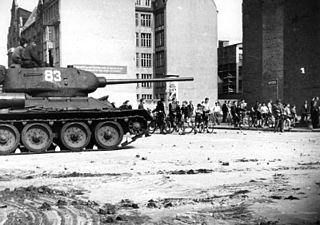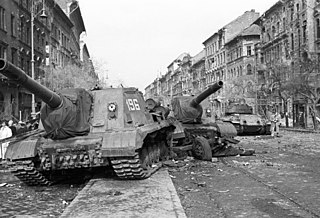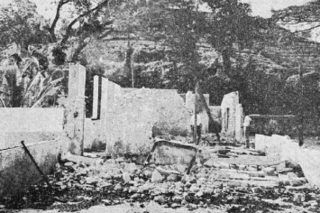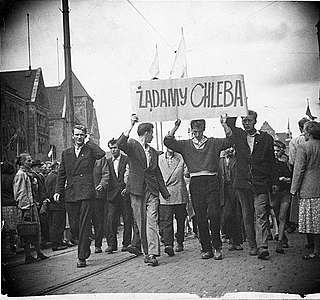 W
WThe 1969 Libyan coup d'état, also known as the al-Fateh Revolution or the 1 September Revolution, was carried out by the Free Unionist Officers Movement, a group of military officers led by Colonel Muammar Gaddafi, which led to the overthrow of King Idris I.
 W
WThe 1970 Polish protests occurred in northern Poland during 14–19 December 1970. The protests were sparked by a sudden increase in the prices of food and other everyday items. Strikes were put down by the Polish People's Army and the Citizen's Militia, resulting in at least 44 people killed and more than 1,000 wounded.
 W
WThe June 1976 protests were a series of protests and demonstrations in the Polish People's Republic that took place after Prime Minister Piotr Jaroszewicz revealed the plan for a sudden increase in the price of many basic commodities, particularly foodstuffs. Prices in Poland were at that time fixed, and controlled by the government, which was falling into increasing debt.
 W
WThe Herat uprising, locally known as the Uprising of 24th Hūt was an insurrection that took place in and around the city of Herat in western Afghanistan, across several days in March 1979. It included both a popular uprising and a mutiny of Afghan Army troops against the Democratic Republic of Afghanistan (DRA). The communist regime at first appealed to its Soviet allies for help, but the Soviet leadership declined to intervene. After the insurgents seized and held the city for about a week, the regime was able to retake it with its own forces, and the subsequent aerial bombardment and recapture of Herat left 3,000 to 25,000 of its inhabitants dead. It was the worst outbreak of armed violence in the country in 50 years, and was the deadliest incident in the 1978-1979 period following the Saur Revolution and before the start of the Soviet occupation.
 W
WThe 1987–1989 JVP insurrection, also known as the 1988–1989 revolt or the JVP troubles, was an armed revolt led by the Marxist Janatha Vimukthi Peramuna against the Government of Sri Lanka, which was led by President J. R. Jayewardene. The revolt, like a preceding insurgency which took place in 1971, was unsuccessful. The insurrection was a low-intensity conflict that lasted from April 1987 to December 1989. The JVP resorted to subversion, assassinations, raids, and attacks on military and civilian targets while the Sri Lankan government reacted through counter-insurgency operations to suppress the revolt.
 W
WThe Rebellion of Brașov was a revolt against Nicolae Ceaușescu's economic policies in Communist Romania, which erupted on the day of the 1987 local election.
 W
WThe Carnation Revolution, also known as the 25 April, was a military coup on 25 April 1974 in Lisbon which overthrew the authoritarian Estado Novo regime, producing fundamental social, economic, territorial, demographic and political changes through the Processo Revolucionário Em Curso, resulting in the Portuguese transition to democracy, and the end of the Portuguese Colonial War.
 W
WThe Communist insurgency in Malaysia, also known as the Second Malayan Emergency, was an armed conflict which occurred in Malaysia from 1968 to 1989, between the Malayan Communist Party (MCP) and Malaysian federal security forces.
 W
WThe communist insurgency in Sarawak occurred in Malaysia from 1962 to 1990, and involved the North Kalimantan Communist Party and the Malaysian Government. It was one of the two Communist insurgencies to challenge the former British colony of Malaysia during the Cold War. As with the earlier Malayan Emergency (1948–1960), the Sarawak Communist insurgents were predominantly ethnic Chinese, who opposed to British rule over Sarawak and later opposed the merger of the state into the newly created Federation of Malaysia. The insurgency was triggered by the 1962 Brunei Revolt, which had been instigated by the left-wing Brunei People's Party in opposition to the proposed formation of Malaysia.
 W
WThe Contras were the various U.S.-backed and funded right-wing rebel groups that were active from 1979 to the early 1990s in opposition to the Marxist Sandinista Junta of National Reconstruction Government in Nicaragua which came to power in 1979 following the Nicaraguan Revolution. Among the separate contra groups, the Nicaraguan Democratic Force (FDN) emerged as the largest by far. In 1987, virtually all contra organizations were united, at least nominally, into the Nicaraguan Resistance.
 W
WDidžioji Kova military district - is a military district of Lithuanian partisans which operated in 1945 - 1950 in the counties of Vilnius, Kaunas and Ukmergė.
 W
WThe East German uprising of 1953 was an uprising that occurred in East Germany from 16 to 17 June 1953. It began with a strike action by construction workers in East Berlin on 16 June against work quotas during the Sovietization process in East Germany. Demonstrations in East Berlin turned into a widespread uprising against the Government of East Germany and the Socialist Unity Party the next day, involving over one million people in about 700 localities across the country. Protests against declining living standards and unpopular Sovietization policies led to a wave of strikes and protests that were not easily brought under control and threatened to overthrow the East German government. The uprising in East Berlin was violently suppressed by tanks of the Soviet forces in Germany and the Kasernierte Volkspolizei, while demonstrations continued in over 500 towns and villages for several more days before dying out.
 W
WThe Central and Eastern European anti-Communist insurgencies fought on after the official end of the Second World War against the Soviet Union and the communist states formed under Soviet occupation and support.
 W
WThe Faciliteitenwet, also known as the "Act on the Position of Moluccans", regulates the position of Moluccans living in the Netherlands who do not hold Dutch nationality.
 W
WThe February 28 incident, also rendered as the February 28 massacre, the 228 incident, or the 228 massacre, was an anti-government uprising in Taiwan that was violently suppressed by governor Chen Yi of the Kuomintang-led Republic of China government, which killed thousands of civilians beginning on February 28, 1947. The number of Taiwanese deaths from the incident and massacre was estimated to be between 18,000 and 28,000. The massacre marked the beginning of the White Terror, in which tens of thousands of other Taiwanese went missing, died, or were imprisoned. The incident is one of the most important events in Taiwan's modern history and was a critical impetus for the Taiwan independence movement.
 W
WThe Guerrilla war in the Baltic states was an armed struggle waged by the Latvian, Lithuanian and Estonian partisans, called the Forest Brothers, against the Soviet Union during the Soviet invasion and occupation of the three Baltic states during and after World War II. Similar anti-Soviet Central and Eastern European resistance groups fought against Soviet and communist rule in Bulgaria, Poland, Romania, and western Ukraine.
 W
WThe Hungarian Revolution of 1956, or the Hungarian Uprising, was a nationwide revolution against the Hungarian People's Republic and its Soviet-imposed policies, lasting from 23 October until 10 November 1956. Leaderless at the beginning, it was the first major threat to Soviet control since the Red Army drove Nazi Germany from its territory at the end of World War II in Europe.
 W
WThe Invasion of Ambon was a combined Indonesian military operation which aimed to seize and annex the self proclaimed Republic of South Maluku.
 W
WThe Jeju uprising, known in South Korea as the Jeju April 3 incident, was an uprising that occurred on Jeju Island from April 1948 to May 1949. Residents of Jeju opposed to the division of Korea had protested and had been on a general strike since 1947 against elections scheduled by the United Nations Temporary Commission on Korea (UNTCOK) to be held only in the territory controlled by the United States Army Military Government in Korea. The Workers' Party of South Korea and its supporters launched an insurgency in April 1948, attacking the police, and Northwest Youth League members stationed on Jeju mobilized to violently suppress the protests. The First Republic of Korea under President Syngman Rhee escalated the suppression of the uprising from August 1948, declaring martial law in November and beginning an "eradication campaign" against rebel forces in the rural areas of Jeju in March 1949, defeating them within two months. Many rebel veterans and suspected sympathizers were later killed upon the outbreak of the Korean War in June 1950, and the existence of the Jeju uprising was officially censored and repressed in South Korea for several decades.
 W
WThe 1971 Janatha Vimukthi Peramuna (JVP) insurrection was the first of two unsuccessful armed revolts conducted by the communist Janatha Vimukthi Peramuna (JVP) against the Government of Sri Lanka under Prime Minister Sirimavo Bandaranaike. The revolt began on 5 April 1971 and lasted till June 1971. The insurgents were able to capture and hold several towns and rural areas for several weeks until they were recaptured by the armed forces. Even though its first attempt to seize power in 1971 was quickly crushed by force, in 1987 this group launched another far more potent insurgency in the south, central and western regions of the country.
 W
WThe Khmer People's National Liberation Armed Forces (KPNLAF) was the military component of the Khmer People's National Liberation Front (KPNLF) a political front organized in 1979 in opposition to the Vietnamese-installed People's Republic of Kampuchea (PRK) regime in Cambodia. The KPNLAF was loyal to Son Sann, a former Prime Minister under Prince Norodom Sihanouk and the founder of the KPNLF political movement.
 W
WThe Khmer People's National Liberation Front was a political front organized in 1979 in opposition to the Vietnamese-installed People's Republic of Kampuchea (PRK) regime in Cambodia. The 200,000 Vietnamese troops supporting the PRK, as well as Khmer Rouge defectors, had ousted the Democratic Kampuchea regime of Pol Pot, and were initially welcomed by the majority of Cambodians as liberators. Some Khmer, though, recalled the two countries' historical rivalry and feared that the Vietnamese would attempt to subjugate the country, and began to oppose their military presence. Members of the KPNLF supported this view.
 W
WThe Lithuanian partisans were partisans who waged a guerrilla warfare in Lithuania against the Soviet Union in 1944–1953. Similar anti-Soviet resistance groups, also known as Forest Brothers and cursed soldiers, fought against Soviet rule in Estonia, Latvia, Poland, Romania and Galicia. It is estimated that a total of 30,000 Lithuanian partisans and their supporters were killed. Lithuanian partisan war lasted almost for a decade, thus being one of the longest partisan war in Europe.
 W
WLithuanian Partisans Declaration of February 16, 1949 is a document, created by Lithuanian partisans and signed by Union of Lithuanian Freedom Fighters (ULFF) on February 16, 1949 in Minaičiai. By signing the declaration, the ULFF assumed responsibility to lead the restoration of independent democratic state of Lithuania, where equal rights for all citizens and social care is guaranteed. Document also states that "Communist party, as dictatorial and essentially opposite to the main aim of Lithuanian nation and keystone provision of the Constitution – independence of Lithuania, – is not considered a legal party". The declaration appeals to the Universal Declaration of Human Rights, Lithuanian Constitution of 1922 and addresses whole democratic world asking for help.
 W
WThe Madiun Affair, known locally as the Communist Party of Indonesia rebellion of 1948, was an armed conflict between the government of the Self-proclaimed Republic of Indonesia and the left-wing opposition group, Front Demokrasi Rakyat during the Indonesian National Revolution. The conflict began on 18 September 1948 in Madiun, East Java, and ended three months later when most FDR leaders and members were detained and executed by TNI forces.
 W
WThe Makassar Uprising was a skirmish in Makassar, Sulawesi between former Royal Dutch East Indies Army soldiers under Captain Andi Aziz and the Republic of the United States of Indonesia government. The purpose of the uprising was to revolt against the incorporation of the Indonesian federated "states" into the Indonesian Republic. However, the uprising was quashed in a little over two weeks when troops under Lieutenant Colonel Suharto and Colonel Alexander Evert Kawilarang arrived at Makassar to find only light resistance.
 W
WPolish October, also known as October 1956, Polish thaw, or Gomułka's thaw, marked a change in the politics of Poland in the second half of 1956. Some social scientists term it the Polish October Revolution, which was less dramatic than the Hungarian Revolution of 1956 but may have had an even deeper impact on the Eastern Bloc and on the Soviet Union's relationship to its satellite states in Central and Eastern Europe.
 W
WThe Poznań protests of 1956, also known as Poznań June, were the first of several massive protests against the communist government of the Polish People's Republic. Demonstrations by workers demanding better working conditions began on 28 June 1956 at Poznań's Cegielski Factories and were met with violent repression.
 W
WThe Revolutions of 1989 formed part of a revolutionary wave in the late 1980s and early 1990s that resulted in the end of communist rule in Central and Eastern Europe, the end of the period of the Cold War, and the removal of the Iron Curtain between Eastern and Western Europe. The period is often also called the Fall of Communism and sometimes the Fall of Nations or the Autumn of Nations, a play on the term Spring of Nations that is sometimes used to describe the Revolutions of 1848.
 W
WThe Romanian anti-communist resistance movement was active from the late 1940s to the mid-1950s, with isolated individual fighters remaining at large until the early 1960s. Armed resistance was the first and most structured form of resistance against the communist regime, which in turn regarded the fighters as "bandits". It was not until the overthrow of Nicolae Ceaușescu in late 1989 that details about what was called "anti-communist armed resistance" were made public. It was only then that the public learned about the several small armed groups, which sometimes termed themselves "haiducs", that had taken refuge in the Carpathian Mountains, where some hid for ten years from authorities. The last fighter was eliminated in the mountains of Banat in 1962. The Romanian resistance was one of the longest lasting armed movements in the former Eastern Bloc.
 W
WThe Afghanistan conflict is a series of wars which have been fought in Afghanistan since 1978. Starting with the Saur Revolution military coup, an almost continuous series of armed conflicts has dominated and afflicted Afghanistan. The wars include:The Saur Revolution (1978) happened when the People's Democratic Party of Afghanistan overthrew the government of the Republic of Afghanistan which was headed by president Mohammed Daoud Khan. It then established the Democratic Republic of Afghanistan, a communist state which allied itself with the USSR. The Soviet–Afghan War (1979–1989) started when the Soviet Army intervened in the country in order to support the ruling People's Democratic Party of Afghanistan (PDPA) following large-scale rebellions against the government. Soviet troops along with the allied Afghan Army fought against rebel factions which were mostly collectively known as the "Afghan mujahideen", whose main backers were the United States, the United Kingdom, China, Pakistan, Saudi Arabia, Israel, Iran, Egypt and West Germany. The Soviet Union eventually withdrew its troops in 1989. The Afghan Civil War (1989–1992) was the continuing war between the government and rebels, but without the involvement of Soviet troops. Nevertheless, the Soviet Union continued to financially support the Afghan government in its fight, and likewise, rebel factions continued to receive support from the United States and Pakistan. The Soviet-backed Afghan government survived until the fall of Kabul in 1992, after which the mujahideen established the Islamic State of Afghanistan. The Afghan Civil War (1992–1996) began when various mujahideen groups withdrew support from and began fighting against the Islamic State, including Hezb-e Islami Gulbuddin, later largely replaced by the Taliban and al-Qaeda, Hezb-i Wahdat and Junbish-i Milli. Mujahideen loyal to the Islamic State were supported by Saudi Arabia. This phase of the war ended when the Taliban captured Kabul and established the partially-recognised Islamic Emirate of Afghanistan. The Afghan Civil War (1996–2001) was the continuation of the previous phase of the war, between militias loyal to the rival Islamic State and Islamic Emirate. Islamic State loyalists reorganised into the Northern Alliance, including Hezb-i Wahdat and Junbish-i Milli, who previously opposed the Islamic State. The Islamic Emirate continued to be supported by Pakistan, now joined by Saudi Arabia, the United Arab Emirates and Qatar, whereas the Northern Alliance were supported by Russia, India, Iran, Turkey, Uzbekistan, Tajikistan, Turkmenistan, Kazakhstan and Kyrgyzstan. Al-Qaeda began committing terrorist attacks against the United States, culminating in the September 11 attacks, after which the Islamic Emirate's international backers officially cut support and diplomatic recognition. The War in Afghanistan (2001–2021) began with the US invasion of Afghanistan on 7 October 2001, when the US sought to remove the Taliban from power as they were hosting al-Qaeda militants, who were the main suspects of the September 11 attacks. The main conflict consisted of Afghan National Army troops, backed by additional United States and NATO troops, fighting against insurgents of the Taliban and sporadically other groups such as al-Qaeda, Haqqani network, Hezb-e Islami Gulbuddin and ISIS-K. After almost twenty years of fighting, the US withdrew its forces, and the Taliban took over Kabul in 2021 in a swift offensive and reinstated its Islamic Emirate of Afghanistan. The ISIL–Taliban conflict began in 2015 as Taliban dissident groups organised into the Islamic State – Khorasan Province, pledging allegiance to the Islamic State of Iraq and the Levant. The group launched attacks against the Taliban as well as NATO troops. ISIS-K continues its insurgency to the present day. The Panjshir conflict began in 2021 when forces loyal to the Islamic Republic reorganised into the National Resistance Front of Afghanistan and retook the Panjshir Valley and later surrounding areas from the Taliban. Despite having international recognition as the legitimate government of Afghanistan, the National Resistance Front received no foreign support, and was condemned by Russia. The Taliban and the National Resistance Front later agreed to a ceasefire.